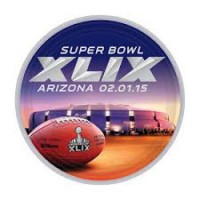Tale of the Super Bowl cities
- Details
- Published on Monday, 26 January 2015 16:52
- Written by PRNewswire
Super Bowl XLIX will be playedFeb. 1at University of PhoenixStadium inGlendale, Ariz.This will be the second time the NFL's championship game will be held inGlendaleand the third time in thePhoenixmetropolitan area.
To commemorate this event, the Census Bureau has compiled a collection of facts examining the demographics of the host metropolitan area, as well as the metro areas represented by the two participants — the New England Patriots and the Seattle Seahawks.
New England (Patriots)
10th
WhereBostonranked on the list of the nation's most populous metropolitan areas. The estimated population of theBoston-Cambridge-Newton, Mass.-N.H., metro area onJuly 1, 2013, was 4,684,299. TheBostonmetro area gained 42,204 people fromJuly 1, 2012, toJuly 1, 2013. At the time of the Patriots' first season in 1960, the 1960 Census population for the city ofBostonwas 697,197.
Source: Census Population Estimates and Decennial Census
http://factfinder.census.gov/bkmk/table/1.0/en/PEP/2013/PEPANNCHG.US24PR
http://www.census.gov/prod/www/decennial.html
44.8%
Percentage ofBostonmetro area residents 25 and older who had a bachelor's degree or higher in 2013; 91.2 percent had at least graduated from high school. The respective national figures were 29.6 percent and 86.6 percent.
Source: 2013 American Community Survey
http://factfinder.census.gov/bkmk/table/1.0/en/ACS/13_1YR/DP02/310M200US14460|310M200US38060|310M200US42660http://factfinder2.census.gov/bkmk/table/1.0/en/ACS/12_1YR/DP02/1600000US5363000
23.4%
Percentage ofBostonmetro area residents 5 and older who spoke a language other than English at home. The national average was 20.8 percent.
Source: 2013 American Community Survey
http://factfinder.census.gov/bkmk/table/1.0/en/ACS/13_1YR/DP02/310M200US14460|310M200US38060|310M200US42660
$72,907
Median household income for theBostonmetro area. The national median was$52,250.
Source: 2013 American Community Survey
http://factfinder.census.gov/bkmk/table/1.0/en/ACS/13_1YR/DP03/310M200US14460|310M200US38060|310M200US42660
$363,200
Median home value of owner-occupied homes in theBostonmetro area. The national median was$173,900.
Source: 2013 American Community Survey
http://factfinder.census.gov/bkmk/table/1.0/en/ACS/13_1YR/DP04/310M200US14460|310M200US38060|310M200US42660
30.0 minutes
Average amount of time it tookBostonmetro area residents to get to work; 68.7 percent of the metro area's workers drove to work alone, 6.9 percent carpooled and 12.8 percent took public transportation. Nationally, it took an average of 25.8 minutes to get to work.
Source: 2013 American Community Survey
http://factfinder.census.gov/bkmk/table/1.0/en/ACS/13_1YR/DP03/310M200US14460|310M200US38060|310M200US42660
Seattle(Seahawks)
15th
WhereSeattleranked on the list of the nation's most populous metropolitan areas. The estimated population of theSeattle-Tacoma-Bellevue, Wash., metro area onJuly 1, 2013, was 3,610,105. TheSeattlearea gained 57,514 people fromJuly 1, 2012, toJuly 1, 2013. At the time of the Seahawks' first season in 1976, the 1970 Census population for the city ofSeattlewas 530,831.
Source: Census Population Estimates and Decennial Census
http://factfinder.census.gov/bkmk/table/1.0/en/PEP/2013/PEPANNCHG.US24PR
http://www.census.gov/prod/www/decennial.html>
39.4%
Percentage ofSeattlemetro area residents 25 and older who had a bachelor's degree or higher in 2013; 91.7 percent had at least graduated from high school. The respective national figures were 29.6 percent and 86.6 percent.
Source: 2013 American Community Survey
http://factfinder.census.gov/bkmk/table/1.0/en/ACS/13_1YR/DP02/310M200US14460|310M200US38060|310M200US42660
22.3%
Percentage ofSeattlemetro area residents 5 and older who spoke a language other than English at home. The national average was 20.8 percent.
Source: 2013 American Community Survey
http://factfinder.census.gov/bkmk/table/1.0/en/ACS/13_1YR/DP02/310M200US14460|310M200US38060|310M200US42660
$67,479
Median household income for theSeattlemetro area. The national median was$52,250.
Source: 2013 American Community Survey
http://factfinder.census.gov/bkmk/table/1.0/en/ACS/13_1YR/DP03/310M200US14460|310M200US38060|310M200US42660
$307,900
Median home value of owner-occupied homes in theSeattlemetro area. The national median was$173,900.
Source: 2013 American Community Survey
http://factfinder.census.gov/bkmk/table/1.0/en/ACS/13_1YR/DP04/310M200US14460|310M200US38060|310M200US42660
28.6 minutes
Average amount of time it tookSeattlemetro area residents to get to work; 69.7 percent of the metro area's workers drove to work alone, 9.9 percent carpooled and 9.3 percent took public transportation. (Note: The percentage of workers that carpooled is not statistically different from the percentage that took public transportation.) Nationally, it took an average of 25.8 minutes to get to work.
Source: 2013 American Community Survey
http://factfinder.census.gov/bkmk/table/1.0/en/ACS/13_1YR/DP03/310M200US14460|310M200US38060|310M200US42660
Host Site
12th
WherePhoenixranked on the list of the nation's most populous metropolitan areas. The estimated population of thePhoenix-Mesa-Scottsdale, Ariz., metro area onJuly 1, 2013, was 4,398,762. ThePhoenixarea gained 71,130 people fromJuly 1, 2012, toJuly 1, 2013.
Source: Census Population Estimates
http://factfinder.census.gov/bkmk/table/1.0/en/PEP/2013/PEPANNCHG.US24PR
234,632
Population ofGlendale, Ariz., location ofUniversity of PhoenixStadium where Super Bowl XLIX will be played.
Source: Census Population Estimates
http://factfinder.census.gov/bkmk/table/1.0/en/PEP/2013/PEPANNRSIP.US12A
87th
WhereGlendaleranked on the list of the nation's most populous cities.
Source: Census Population Estimates
http://factfinder.census.gov/bkmk/table/1.0/en/PEP/2013/PEPANNRSIP.US12A
29.2%
Percentage ofPhoenixmetro area residents 25 and older who had a bachelor's degree or higher in 2013, which is not statistically different from the national figure of 29.6 percent; 86.5 percent had at least graduated from high school, which is not statistically different from the national figure of 86.6 percent. Source: 2013 American Community Survey
http://factfinder.census.gov/bkmk/table/1.0/en/ACS/13_1YR/DP02/310M200US14460|310M200US38060|310M200US42660
25.8%
Percentage ofPhoenixmetro area residents 5 and older who spoke a language other than English at home. The national figure was 20.8 percent.
Source: 2013 American Community Survey
http://factfinder.census.gov/bkmk/table/1.0/en/ACS/13_1YR/DP02/310M200US14460|310M200US38060|310M200US42660
$51,847
Median household income for thePhoenixmetro area, which is not statistically different from the national median of$52,250.
Source: 2013 American Community Survey
http://factfinder.census.gov/bkmk/table/1.0/en/ACS/13_1YR/DP03/310M200US14460|310M200US38060|310M200US42660
$177,900
Median home value of owner-occupied homes in thePhoenixmetro area. The national median was$173,900.
Source: 2013 American Community Survey
http://factfinder.census.gov/bkmk/table/1.0/en/ACS/13_1YR/DP04/310M200US14460|310M200US38060|310M200US42660http://factfinder2.census.gov/bkmk/table/1.0/en/ACS/12_1YR/DP04/1600000US3651000
25.8 minutes
Average amount of time it tookPhoenixmetro area residents to get to work; 76.5 percent of the metro area's workers drove to work alone, 10.9 percent carpooled and 2.6 percent took public transportation. Nationally, it also took an average of 25.8 minutes to get to work.
Source: 2013 American Community Survey

















































